On May 14 we got a (long-anticipated) first-look at Season 2 of The Lord of the Rings: The Rings of Power from Amazon Prime Video. TORn has already posted a staff trailer reaction and some from-the-hip analysis. There’s still much to dissect from both teaser trailer and the accompanying behind-the-scenes video.
Today, however, TORn Discord regular Webcrawler is eager to analyse some scenes from the teaser trailer that hint at the S2 plot of Númenor, starting with one question…
***************
Why is Pharazôn standing in front of an Eagle with a drawn sword?
by TORn Discord Regular Webcrawler
Some here at TORn have speculated this doesn’t bode well for the eagle, nor for Númenor. After all, Pharazôn isn’t one of the Faithful, and wouldn’t hold them in the same sort of respect. But connecting some dots through other scenes and the lore may provide a clue about what’s truly occuring.
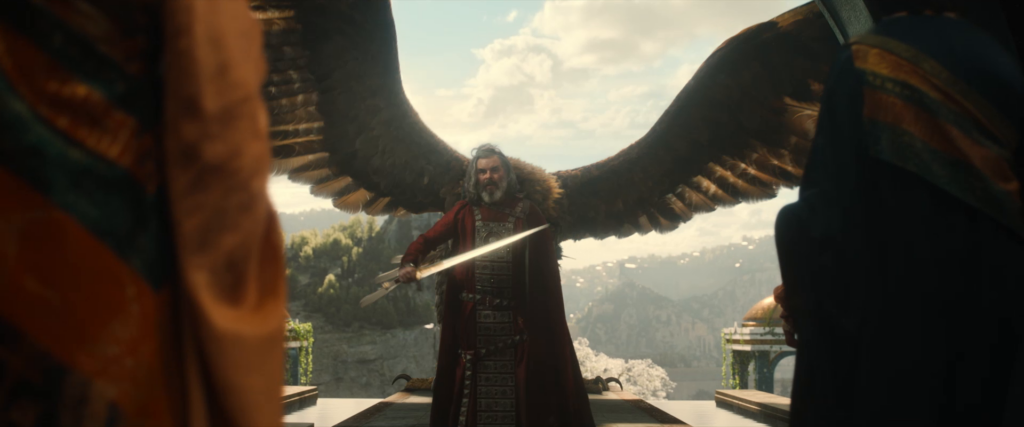
The Eagles lived in the northern regions of Númenor, in the northern cape of Forostar. Up until the time of Tar-Ancalimon, there was also a nest of golden eagles at the summit of the tower in the King’s Palace. This would be the same tower where Tar-Palantir was held in The Rings of Power Season 1. Plus, there were three Eagles, known as the Witnesses of Manwë, that lived near the peak of the Meneltarma.
“The Forostar was the least fertile part; stony, with few trees, save that on the westward slopes of the high heather-covered moors there were woods of fir and larch. Towards the North Cape the land rose to rocky heights, and there great Sorontil rose sheer from the sea in tremendous cliffs. Here was the abode of many eagles.”
The Fall of Númenor

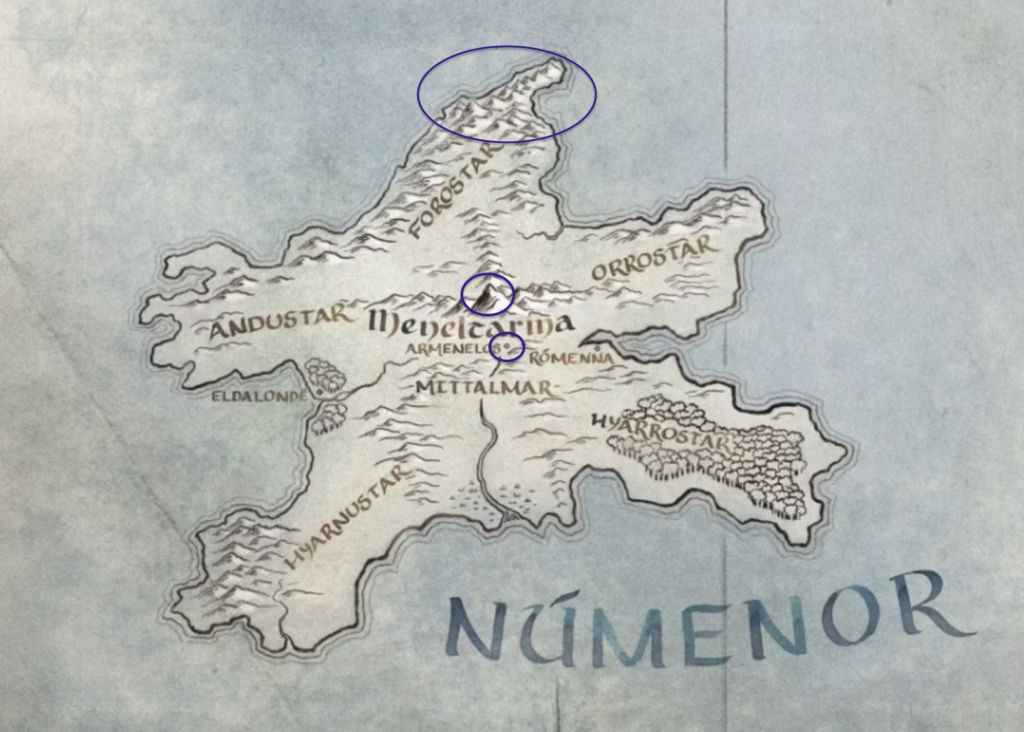
We have seen the King’s Tower in Season 1 of The Rings of Power, and there was no indication that any eagles currently nested atop the tower. This is because in Season 1 the Númenoreans no longer hold faith in the Valar and had let go of the old ways. So this could mean the Eagle comes from either the far north, or from the summit of Meneltarma.
“To the great eagles that were held sacred to Manwë, and never afflicted, until the days of evil and the hatred of the Valar began. For two thousand years, from the days of Elros Tar-Minyatur until the time of Tar-Ancalimon son of Tar-Atanamir, there was an eyrie in the summit of the tower of the King’s palace in Armenelos; and there one pair ever dwelt and lived on the bounty of the King.”
The Fall of Númenor
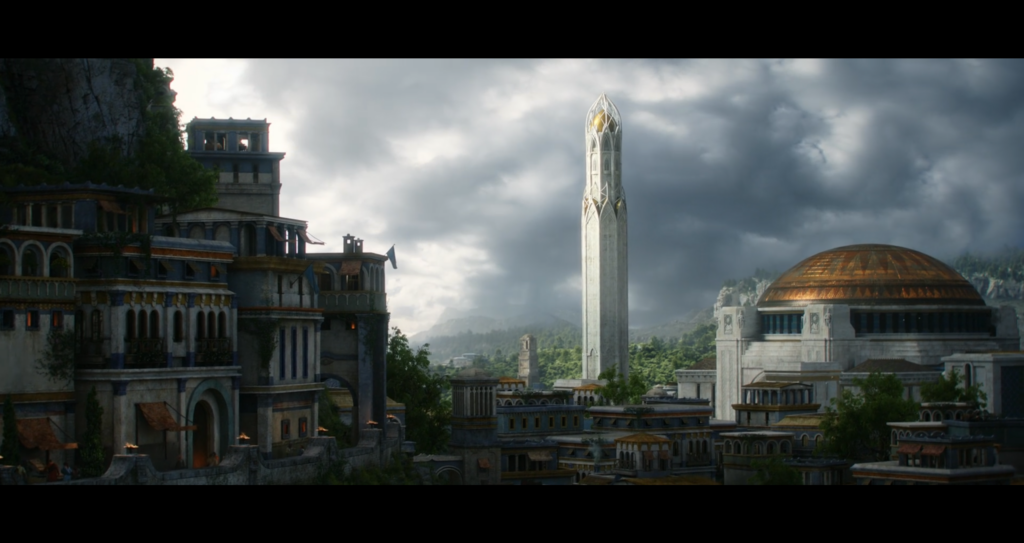
In S1E3, “Adar”, Miriel makes a passing reference to the ban of elves by Tar-Atanamir. This would have marked the beginning of Númenor’s rejection of the Valar. The text above indicates that starting from the time of the reign of Tar-Atanamir’s son, there would no longer be an Eagle’s nest in the King’s Tower as well as a ban on the elves.
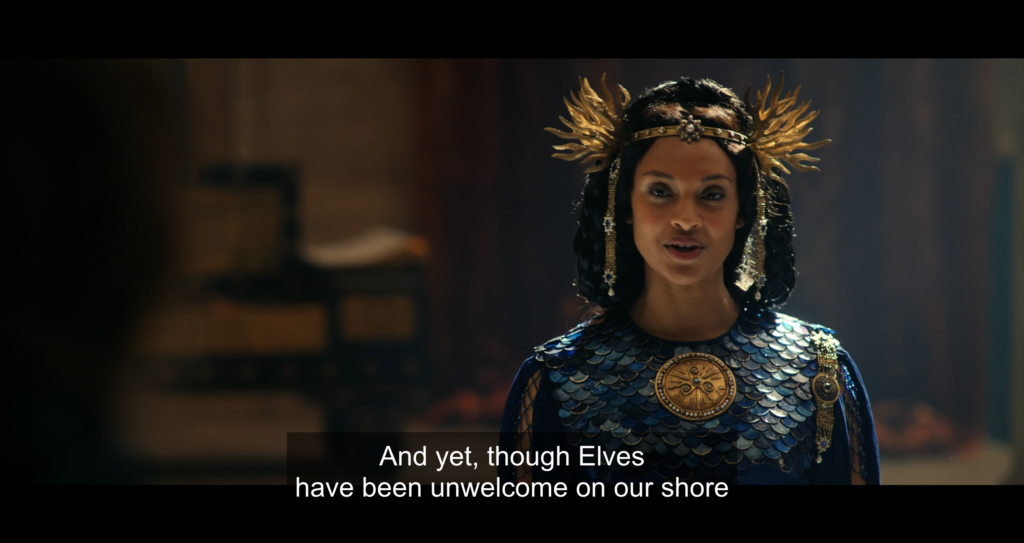
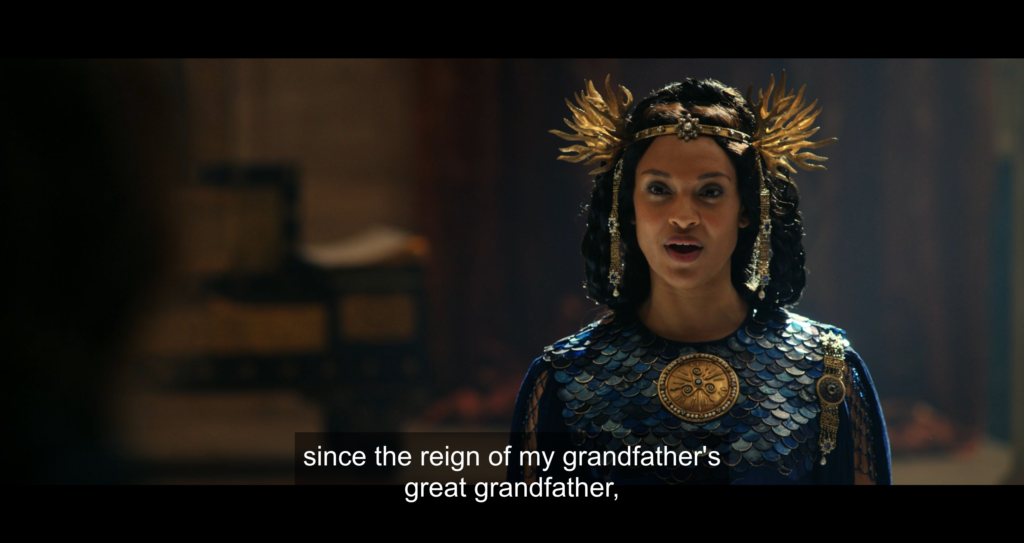
So, does this mean that Pharazôn means to take it one step further, and kill an eagle? To answer that we need to examine another moment revealed in the behind-the-scenes video.
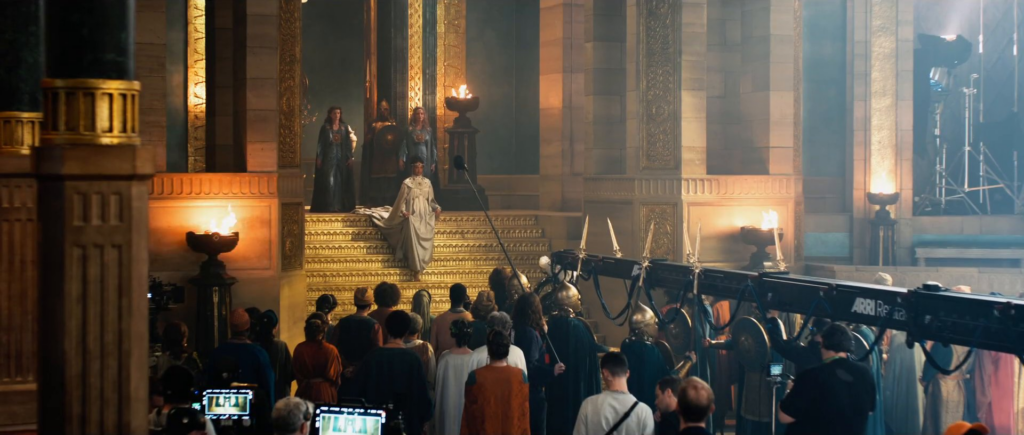
Upon closer inspection of the picture, it seems like Miriel is wearing the same circlet she wore in Season 1. Clearly, upon returning to Númenor from the expedition, she hasn’t lost her status as Queen Regent, nor as possibly the future Queen. The white outfit however is new, and looks quite ceremonial. A brief description in The Fall of Númenor explains that the King would wear a white ceremonial outfit when it came to offering prayers at the Meneltarma.
“Thrice only in each year the King spoke, offering prayer for the coming year at the Erukyermë in the first days of spring, praise of Eru Ilúvatar at the Erulaitalë in midsummer, and thanksgiving to him at the Eruhantalë at the end of autumn. At these times the King ascended the mountain on foot followed by a great concourse of the people, clad in white and garlanded, but silent.” [Ed.: emphasis added]
The Fall of Númenor
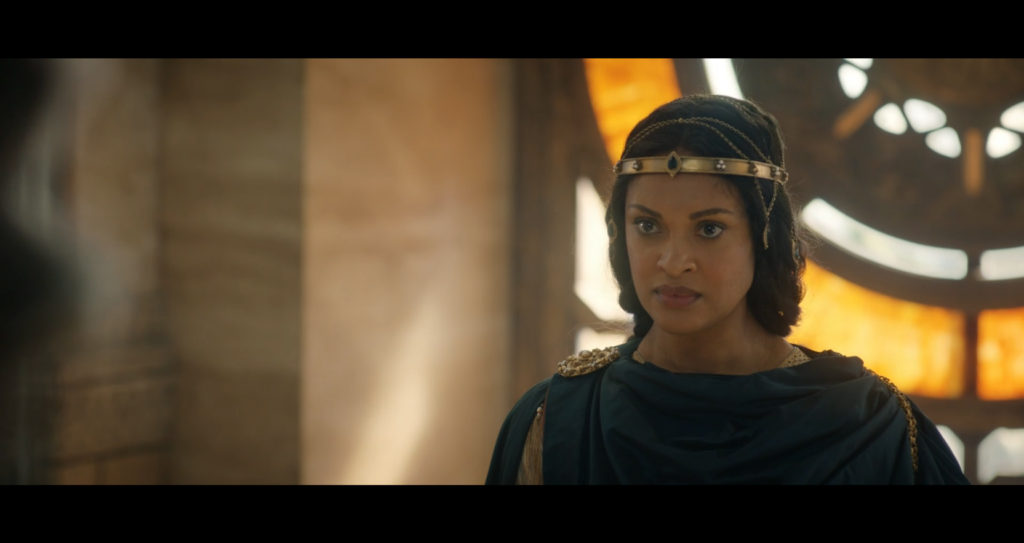
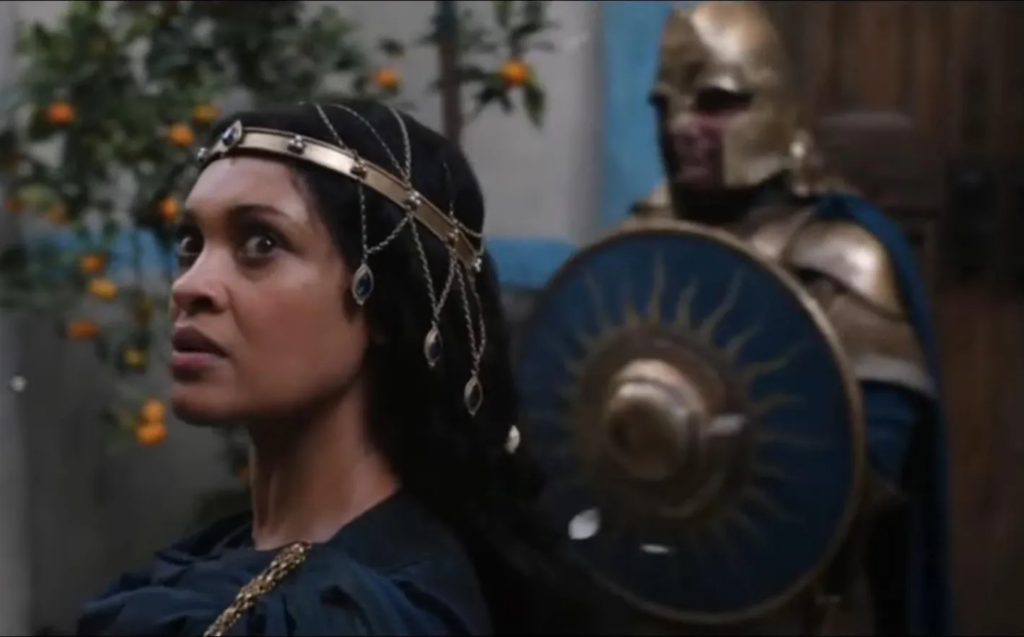
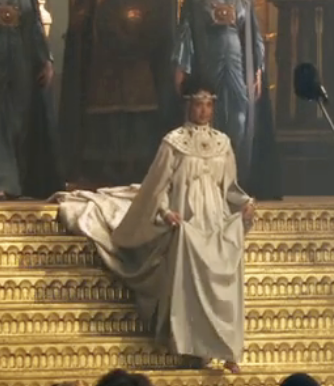
This is the same royal court we see in Season 1, and we have another picture of Pharazôn in this location wearing his new red outfit. All these images are from the same single scene. Clearly, these seems to be a ceremonial event taking place; instead of at the Meneltarma, the show has decided to do it in Armenelos. The text also tells us that three eagles circle the Meneltarma during the prayer offerings, and this is seen as a sign of a blessing from the Valar.
“If anyone approached the summit, at once three eagles would appear and alight upon three rocks near to the western edge; but at the times of the Three Prayers they did not descend, remaining in the sky and hovering above the people They were called the Witnesses of Manwë, and they were believed to be sent by him from Aman to keep watch upon the Holy Mountain and upon all the land.” [Ed.: emphasis added]
The Fall of Númenor
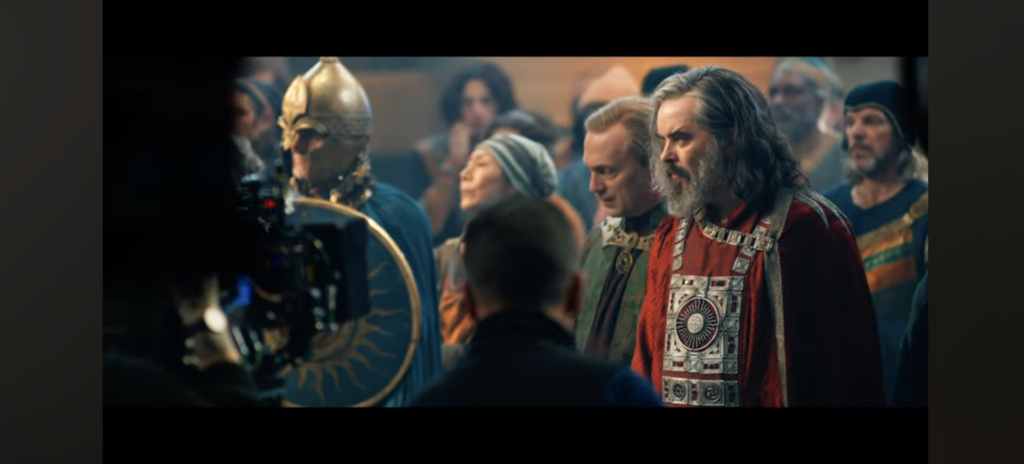
However, the text also says the eagles do not descend during the prayers, so why does it do so here? We know from the lore that Tolkien’s eagles are wise, and are messengers of Manwë. So is it possible it’s come down to give the Númenoreans a message?
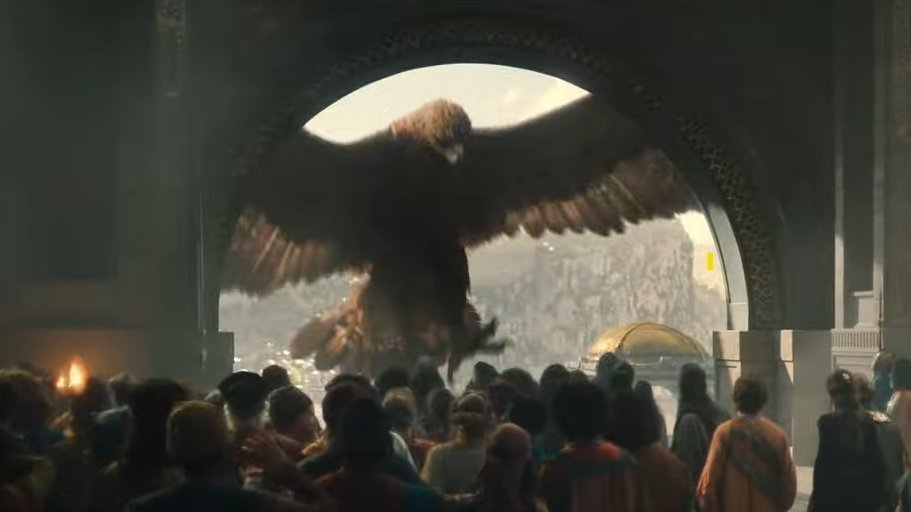
One major plot point that could be covered in Season 2 of The Rings of Power is the Battle of Gwathló, or the arrival of the Númenoreans in Middle-earth to aid and defend Lindon after the Siege of Eriador. We’ve mentioned previously that set leaks have shown the Siege of Eregion is happening in Season 2. We see images of the siege of Eregion in the teaser trailer. In the text the siege and further attack on Eriador by Sauron’s forces takes place long before Elendil’s time, but obviously for the show the timeline has been rearranged and condensed.
1697 Eregion laid waste. Death of Celebrimbor. The gates of Moria are shut. Elrond retreats with remnant of the Noldor and founds the refuge of Imladris.
The Lord of the Rings. Appendix B. The Tale of Years.
1699 Sauron overruns Eriador.
1700 Tar-Minastir sends a great navy from Númenor to Lindon. Sauron is defeated.
1701 Sauron is driven out of Eriador. The Westlands have peace for a long while.
So it’s quite possible, given that the elves of Middle-earth and Lindon have no communication with one another, that the eagle of Manwë is used as a messenger to call Númenor to arms once again. There is another leak by Fellowship of Fans that mentions a “Telperiën Bay” as a location.
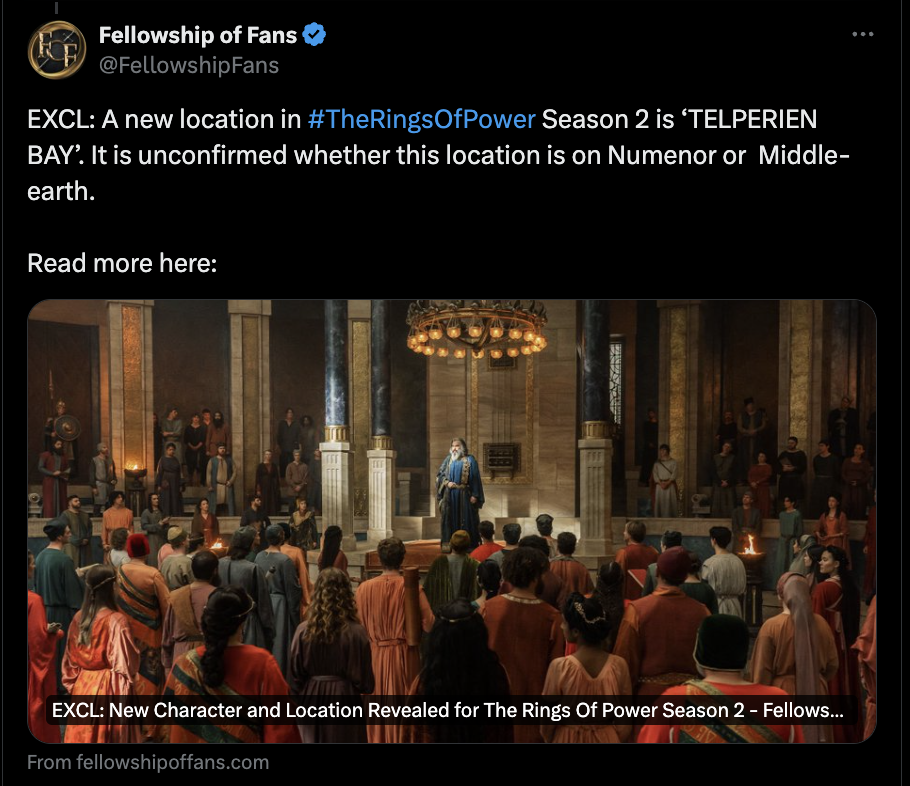
There is no Telperiën Bay in the Legendarium, but there is a Tar-Telperiën, the tenth ruler of Númenor and the second ruling Queen. Here is what it says about here rule in the Unfinished Tales:
X Tar-Telperien
Unfinished Tales: The Line of Elros: The Kings of Númenor
She was the second Ruling Queen of Númenor. She was long-lived (for the women of the Númenóreans had the longer life, or laid down their lives less easily), and she would wed with no man. Therefore after her day the sceptre passed to Minastir; he was the son of Isilmo, the second child of Tar-Súrion. 8 Tar-Telperien was born in the year 1320; she ruled for 175 years, until 1731, and died in that same year.
It was during her rule that Tar-Minastir sent the Númenorean forces in 1700 to help Lindon against Sauron’s forces. So it is quite possible this “bay” is a sly hint to Tar-Telperiën’s actions in lore. Thus we could infer the formation of a Númenorean naval force to come to the aid of Lindon.
And who could lead this force? Well, maybe, the person drawing the sword.
We know that eventually Pharazôn arrives with an army at Umbar to assail Sauron. At this point, Sauron surrenders himself. But that happens long after Tar-Minastir’s time. And so, having condensed the timeline of the show, what seems most likely is that the show is moving Pharazon’s fleet arriving in Middle-earth to right after the Siege of Eregion, during the War of the Elves and Sauron just as Sauron’s forces assail Lindon.
So why does Pharazôn draw his sword? If he meant to attack the Eagle, he would draw it towards the eagle; but he draws it while facing his fellow Númenoreans with the Eagle behind him. Lindon calls for aid. And well…
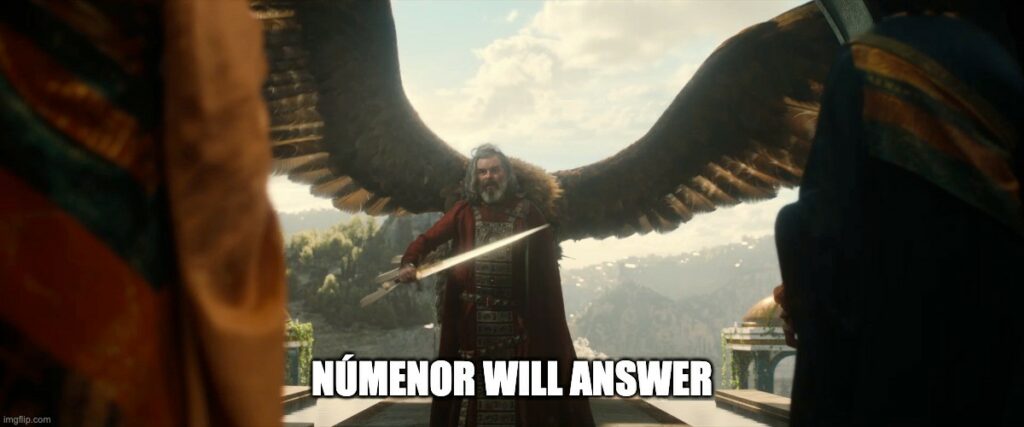
About the author: Webcrawler is a full-time data analyst and a part-time Tolkien aficionado who frequents the TheOneRing.net Discord Server. When he’s not working or in the discord, Webcrawler is horsing around on Twitter.



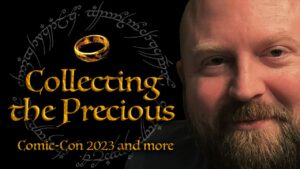 This year, instead of a booth tour, we’re going to go on a tour of the things you could see at Comic-Con 2023 that were Middle-earth related. During this video, we stop at
This year, instead of a booth tour, we’re going to go on a tour of the things you could see at Comic-Con 2023 that were Middle-earth related. During this video, we stop at 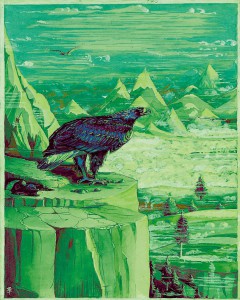 There’s always a great deal of
There’s always a great deal of 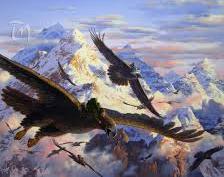 In this piece over on io9, Gibbelins discusses why Tolkien knew exactly what he was doing when he was using the Eagles of Manwë. It’s a bit sweary at times, so if you’re put off by strong language this is probably not the article for you. Good, thoughtful writing though.
In this piece over on io9, Gibbelins discusses why Tolkien knew exactly what he was doing when he was using the Eagles of Manwë. It’s a bit sweary at times, so if you’re put off by strong language this is probably not the article for you. Good, thoughtful writing though. 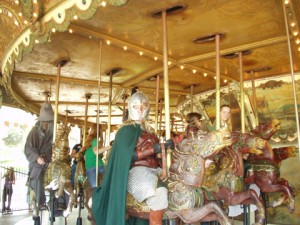 Q:
Q: